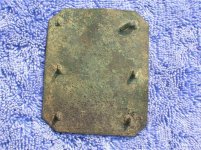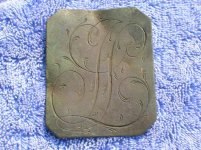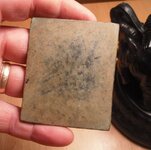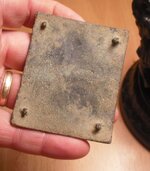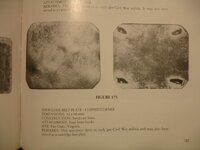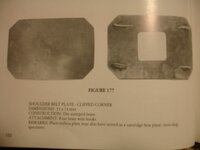artyfacts
Bronze Member
- May 1, 2010
- 1,144
- 1,239
- 🥇 Banner finds
- 3
- Detector(s) used
- Whites DFX, MX7, Minelab Manticore
- Primary Interest:
- All Treasure Hunting
Spent five hours on a new site today with a large cellar hole, on a hill, in the woods, along the shoreline. I think the site was worked by someone with an older machine. All of iron was left behind, big stuff and small between 8 and 15 inches deep. The non ferrous items were found next to the iron. When I walked up to the site the first thing I dug was a broken axe head and found the button in the same hole I thought the place was going to be loaded. I was wrong it was already picked. I'm still happy with the iron and the few other items I found. The buckle was found on the top of the log splitter in the same hole. The buzzer is the third I have dug in two different sites in the last month. The suspender buckle still has some gilt left on it and its a little on the fancy side. The brass item is two inches long. I know it was nailed to the tip of something. Any Ideas? The little iron spike could it be to a spear or is it a awl? The full axe was sweet, 7 1/2 inches long. Its going to clean up nice, I like finding axes. Lantern parts, scythe, draw knife and -----the ticks are out. Arty
Attachments
Upvote
0


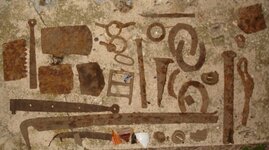
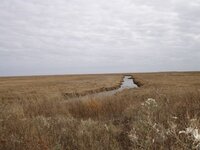
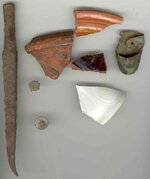
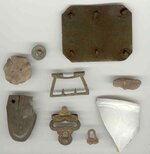
 (Think Grim Reaper)
(Think Grim Reaper) 


 ) At any rate , Arty , you have been a real pitbull in your "dogged" pursuit of the top trunk restorers evidence (the only people who see the back attachment mode) pertaining to this age old dispute , and hope your continued efforts find all the evidence or lack of, to finally arrive at a consensus ; based on the FACTS. My hat go's off to you. ......(I myself was fairly convinced "trunk plate" after being on the fence for years.) Now I'm back on the fence again thinking , "hey , maybe leather". Say , Anyone know if early trunks wore beltplates
) At any rate , Arty , you have been a real pitbull in your "dogged" pursuit of the top trunk restorers evidence (the only people who see the back attachment mode) pertaining to this age old dispute , and hope your continued efforts find all the evidence or lack of, to finally arrive at a consensus ; based on the FACTS. My hat go's off to you. ......(I myself was fairly convinced "trunk plate" after being on the fence for years.) Now I'm back on the fence again thinking , "hey , maybe leather". Say , Anyone know if early trunks wore beltplates 